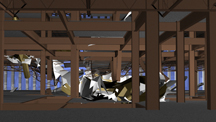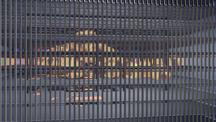WEST LAFAYETTE, Ind. -
Although most Americans believe they know what brought down the World Trade Center twin towers on Sept. 11, 2001, civil engineers are still seeking answers to questions that could save lives in the future.
Structural engineers need to know from a scientific perspective what happened to the buildings during the terrorist attacks in order to prevent future failures. The search for answers continues with the help of a state-of-the-art animated visualization created by researchers at Purdue University.
Christoph Hoffmann, a professor of computer science and director of Purdue's Rosen Center for Advanced Computing, a division of Information Technology at Purdue, says the animation reveals more information than could be conveyed through a scientific simulation alone.
"Scientific simulations restrict us to showing the things
Disintegrating fuselage of plane after impact
Download image
caption below
 |
that are absolutely essential to the engineer," Hoffmann says. "This gives us a simulation that doesn't deliver much visual information to a layperson. Our animation takes that scientific model and adds back the visual information required to make it a more effective communication tool."
The scientific simulation, the completion of which was announced last September, required several test runs before the researchers were satisfied; the final test run required more than 80 hours of high-performance computing. The simulation depicts how a plane tore through several stories of the World Trade Center north tower within a half-second and found that the weight of the fuel acted like a flash flood of flaming liquid, knocking out essential structural columns within the building and removing fireproofing insulation from other support structures. The simulation used lines and dots to show the aircraft and building during the event.
To develop the new animated visualization, Voicu Popescu, an assistant professor of computer science, developed a translator application that creates a link between computer simulations and computer visualization systems to automatically translate simulation data into a 3-D animation scene.
"This translator is scalable and can be used in other simulations," Popescu says.
The animation (122 MB) can be seen online at http://www.cs.purdue.edu/cgvlab/papers/
popescu/popescuWTCVIS07.mov
A faster-loading version (9 MB) of the video can be found at http://news.uns.purdue.edu/mov/2007/HoffmannWTC.mov
In the animation, elements that were not part of the scientific simulation, such as flames and smoke, are clearly rendered, although the visualization does not show the subsequent effects of the fire.
Even though details were added in this animation, Popescu says the visualization was intentionally kept "non-descript" so that they would not be exploitive of the horrific attack.
"For example, on the airplane there are no airline insignia or windows," Popescu says.
Still, Popescu says the visualization has a realism never seen before.
"The crashes and computer models you often see on television are not scientifically accurate," he says. "This provides an alternative that is useful to the nonexpert but is also scientifically accurate, so it provides a more realistic picture of the event."
The visualization begins with a Google Earth map of lower Manhattan as it appeared on Sept. 11, 2001. The video then shows the damage caused by the aircraft as it hit the north tower, follows the disintegrating plane through the interior, and then shows the airplane metal, ignited fuel, dust and smoke exiting the building on the opposite side.
The simulation found that the airplane's metal skin peeled away shortly after impact and shows how the titanium jet engine shafts flew through the building like bullets.
As with an earlier simulation developed by this team that examined the 9/11 attack on the Pentagon, the World Trade Center simulation showed that it was the weight of the 10,000 gallons of fuel more than anything else that caused the damage.
"It is the weight, the kinetic energy of the fuel that causes much of the damage in these events," Hoffmann says. "If it weren't for the subsequent fire, the structural damage might be almost the same if the planes had been filled with water instead of fuel."
Mete Sozen, Purdue's Kettlehut Distinguished Professor of Structural Engineering and a principal investigator on the simulation project, says the researchers worked for years and used the best computing resources available to recreate the event.
"To estimate the serious damage to the World Trade Center core columns, we assembled a detailed numerical model of the impacting aircraft as well as a detailed numerical model of the top 20 stories of the building," Sozen says. "We then used weeks of supercomputer time over a number of years to simulate the event in many credible angles of impact of the aircraft."
Sozen says the actual damage to the building's facade that was observed was identical to the damage shown by the numerical simulation.
"We calibrated our calculations using data from experiments we had conducted to evaluate the energy imparted from fluid moving at high speed to solid targets," he says. "We concluded that the damage map we calculated for our numerical model of the building would correspond closely to the actual extent of the damage."
The simulation represented the plane and its mass as a mesh of hundreds of thousands of "finite elements," or small squares containing specific physical characteristics. In the visualization, these scientific data points are used to show how airplane components swept through the building and out through the other side as the fuel ignited.
"The aircraft moved through the building as if it were a hot and fast lava flow," Sozen says. "Consequently, much of the fireproofing insulation was ripped off the structure. Even if all of the columns and girders had survived the impact - an unlikely event - the structure would fail as the result of a buckling of the columns. The heat from an ordinary office fire would suffice to soften and weaken the unprotected steel. Evaluation of the effects of the fire on the core column structure, with the insulation removed by the impact, showed that collapse would follow whatever the number of columns cut at the time of the impact."
The animation is the latest in a series of projects by the Purdue team that arose after 9/11 to determine the structural damage that occurs when an airplane collides with a building. Although one goal was to develop structures that can withstand a terrorist attack, the team also has used this research to investigate other scenarios, such as an airplane inadvertently crashing into a building located near an airport.
"This is important work that has many more applications than we first thought," Hoffmann says. "The important thing is that we are learning so much in so many different areas."
The research was funded in part by the National Science Foundation.
Others involved in the research are civil engineering assistant professors Ayhan Irfanoglu and Santiago Puiol, computer science doctoral student Paul Rosen, and civil engineering doctoral students Oscar Ardila and Ingo Brachmann.
Writer: Steve Tally, (765) 494-9809, tally@purdue.edu
Sources: Christoph Hoffmann, (765) 494-6185, cmh@cs.purdue.edu
Voicu Popescu, (765) 496-7347, popescu@cs.purdue.edu
Mete Sozen, (765) 494-2186, sozen@purdue.edu
Purdue News Service: (765) 494-2096; purduenews@purdue.edu
Note to Journalists: Broadcast-quality DVDs of the animation without the researcher's narration are available in both standard quality and high definition from Steve Tally, (765) 494-9809, tally@purdue.edu
IMAGE CAPTION 1:
Purdue researchers have developed a scientifically based video animation of the 9/11 attacks on the World Trade Center. Their research has found that it was the weight of the fuel combined with the fire, and not the aircraft itself, that caused the most damage to the buildings. This information can be used by engineers to build new structures that are better able to withstand such attacks, the researchers say. (Purdue University image/Voicu Popescu)
IMAGE CAPTION 2:
A scientifically based video animation of the 9/11 attacks on the World Trade Center by researchers at Purdue shows that it was the weight of the fuel combined with the fire, and not the aircraft itself, that caused the most damage to the buildings. Only a few parts of the airplane, such as the titanium jet propeller shafts, actually continued through the building, the researchers say. (Purdue University image/Voicu Popescu)

